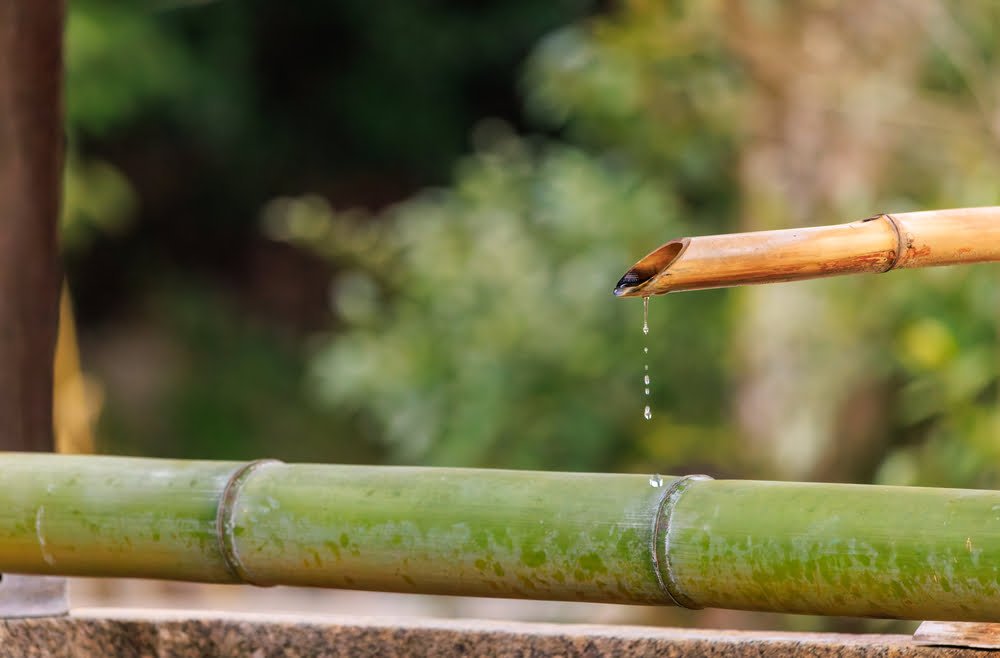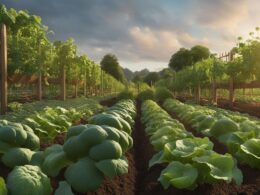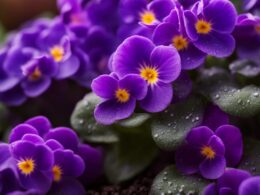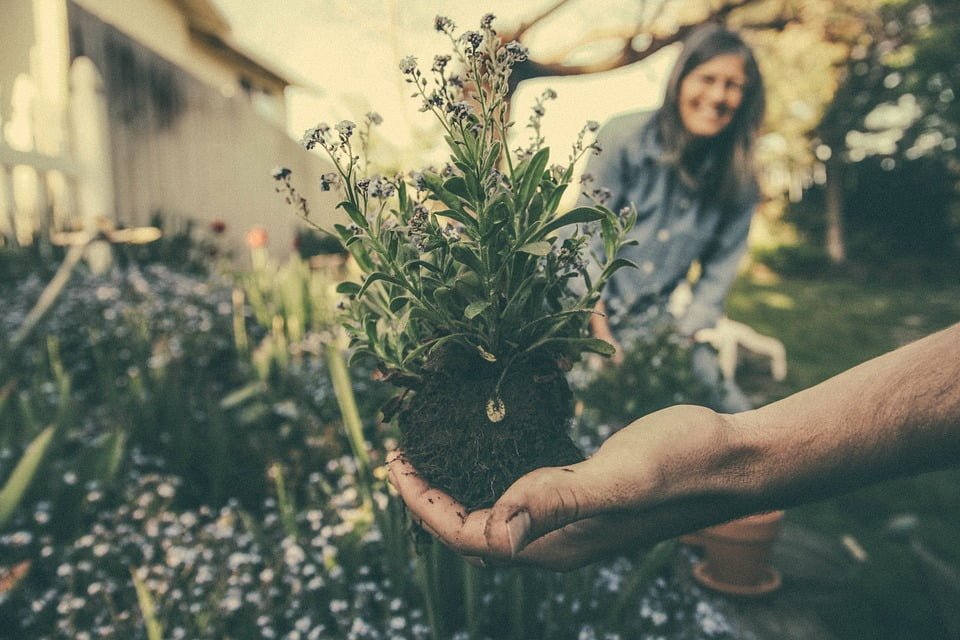Are you tired of seeing your garden suffer due to water scarcity or harsh chemicals? Don’t worry, we’ve got you covered!
It’s time to make a change and adopt eco-friendly solutions for irrigating your beautiful plants. This way, not only will you be saving the environment, but also ensuring that your lush green space remains healthy and safe.
In this article, we’re going to share some simple yet effective methods of keeping your garden hydrated without harming Mother Earth. We promise these techniques are easy enough for anyone to follow – even if you’re new to gardening!
So let’s dive right in and learn how to quench your garden’s thirst while still being environmentally responsible.
1. Rainwater Harvesting Techniques
Imagine a thirsty garden, waiting for the heavens to pour down their precious gift of rain. The plants stretch out their leaves and roots, desperate for nourishment. And then, when the skies finally open up and deliver that life-giving water, it is collected in barrels, buckets, or even underground tanks instead of just flowing away unused.
This simple act can make all the difference between a withering plot of land and flourishing greenery. Rainwater harvesting is not only an eco-friendly way to quench your garden’s thirst but also a technique that adds an extra layer of safety by reducing dependency on external sources like municipal water supplies.
There are numerous ways to capture this valuable resource right at home without breaking the bank or compromising on style. One popular method involves installing gutters around rooftops which collect runoff into barrels placed strategically beneath them. Another option is building swales – long trenches designed to slow down surface flow so that water has time to infiltrate the soil before eventually reaching storage tanks.
Regardless of which system you choose, rest assured that your investment will be well worth it as you provide your beloved plants with natural hydration straight from Mother Earth herself. Plus, you’ll feel secure knowing that despite any potential threats to your local water supply (such as droughts), your lush oasis will continue thriving thanks to its reliable source: rainwater harvesting techniques!
2. Install Drip Irrigation Systems
One of the best ways to create a water-efficient garden is by installing drip irrigation systems. Drip irrigation, also known as micro-irrigation or trickle irrigation, delivers water slowly and directly to the roots of plants through a network of tubes, emitters, and valves. This method not only conserves water but also helps maintain healthy plant growth with less effort.
Setting up a drip irrigation system may seem like a daunting task at first, but it’s actually quite simple once you get started. Begin by planning your layout based on your garden’s size and shape. Measure carefully so that you can purchase enough tubing and fittings for the entire area.
Next, choose appropriate emitters depending on the types of plants in your garden; some need more frequent watering than others. When assembling the system, cut lengths of tubing according to your measurements and connect them using various connectors such as elbows or tees if needed. Attach an emitter at each plant location along with any other necessary components like filters or pressure regulators.
Don’t worry too much about making mistakes during installation – most parts are easily adjustable or replaceable if something goes wrong! After completing setup, test out your new drip irrigation system by running water through it to ensure there are no leaks or clogs before burying any exposed hoses under mulch or soil for added protection from damage due to sun exposure or accidental cutting while gardening.
With regular maintenance checks throughout growing seasons, this eco-friendly solution will keep both you and Mother Earth happy for years to come!
3. Utilize Soaker Hoses
Have you ever considered using soaker hoses as an eco-friendly solution for garden irrigation?
Soaker hoses are a great way to deliver water directly to your plants’ roots while conserving water and reducing evaporation. They work by releasing water slowly through small pores along the length of the hose, ensuring that the soil around your plants stays consistently moist. This method not only keeps your plants healthy but also saves time spent watering.
Installing soaker hoses is easy and can be customized according to your garden’s needs. Start by laying them out in a pattern that covers all of your plants, making sure they are no more than 18 inches apart for optimal coverage. You can snake them between rows or wrap them around individual plants if necessary.
Once positioned, connect them to a timer-controlled faucet with a pressure regulator to prevent overwatering and ensure efficient use of water resources. Moreover, this system offers safety benefits because it reduces the risk of drowning accidents among children who may play near traditional sprinkler systems.
So why choose soaker hoses for your garden irrigation needs? Opting for these environmentally friendly tools not only helps conserve precious water resources but also promotes healthier plant growth due to their targeted delivery system. Plus, they provide peace of mind knowing you’re doing something good for both Mother Nature and yourself – without compromising on safety concerns.
Making this simple switch could make a significant difference in our environment while keeping your garden lush and thriving!
4. Mulch To Retain Moisture
After setting up your soaker hoses, you’re already on the right track to having an eco-friendly garden.
But wait, there’s more!
One of the best ways to ensure that your plants stay healthy and hydrated while conserving water is by using mulch.
Mulching is a simple yet effective technique that involves spreading organic or inorganic materials around the base of your plants.
This helps keep the soil cool and retain moisture longer, which means less watering for you.
Not only does it save water, but it also creates a protective barrier against harsh weather conditions and pests.
Mulches like wood chips, straw, leaves or even stones can be used depending on what suits your garden needs best.
Now that you’ve learned about this amazing method called mulching, why not give it a try?
You’ll find that adding mulch to your garden will create an environment where both plants and beneficial insects thrive.
Plus, with less need for frequent watering, you’ll have more time to enjoy the beauty of your eco-friendly oasis.
So go ahead and spread some mulch – Mother Nature will thank you!
5. Plant Drought-Resistant Varieties
One of the best ways to conserve water in your garden is by planting drought-resistant varieties. These plants require less water, thrive in dry conditions, and help you maintain a beautiful landscape without putting too much strain on our precious resources. Drought-tolerant plants not only save water, they also provide a sense of safety for those who worry about the long-term effects of climate change.
Here are four great options for drought-resistant plants to consider adding to your garden:
- Lavender: This aromatic plant can tolerate both heat and lack of rainfall while still producing gorgeous purple blooms.
- Sage: A popular herb with many culinary uses, sage comes in various colors and thrives in well-draining soil with little moisture.
- succulents: There are countless types of succulents that store water within their leaves or stems; these low-maintenance beauties need minimal watering.
- Yarrow: With its clusters of tiny flowers and feathery foliage, yarrow comes in various colors and can withstand periods of drought.
By incorporating these sturdy plants into your garden’s design, you create an environment more resilient against fluctuations in weather patterns while saving valuable water resources at the same time.
Homeowners will enjoy peace of mind knowing that their gardens continue to flourish even during times when water restrictions may be enforced due to environmental concerns.
So go ahead – give some thought to adding these tough yet attractive plants to your outdoor space this year!
As we all strive towards living more eco-friendly lifestyles, choosing drought-resistant varieties is just one small step that can make a big difference over time. Your garden will look stunning throughout the seasons while requiring less maintenance and using fewer natural resources – it’s a win-win situation for everyone involved!
6. Water At The Right Time
Now that we’ve discussed planting drought-resistant varieties, let’s dive into another important aspect of eco-friendly garden irrigation – watering at the right time. Timing is crucial when it comes to maintaining a healthy and sustainable garden. By understanding the best times to water your plants, you can maximize their growth while also conserving precious resources.
The early morning hours are an ideal time for watering your garden. This is because the temperatures are cooler and there’s usually less wind, which means that more water will be absorbed by the plants rather than evaporating into the air.
Additionally, watering in the morning gives your plants a chance to absorb moisture before the heat of the day sets in, helping them stay hydrated and strong throughout those hot summer afternoons.
If mornings don’t work out for you, late afternoon or early evening can also be good options as long as you allow enough time for your plants to dry off before nightfall – this helps prevent fungal diseases from taking hold.
By making sure to water our gardens at optimal times, we’re not only supporting plant health but also contributing to overall environmental sustainability efforts. So go ahead and set those alarms or reminders on your phone to help keep track of when it’s time to give your thirsty plants a much-needed drink!
Just remember that every little bit counts when it comes down to keeping both our gardens and planet happy and healthy.
7. Create Swales And Berms
Swales and Berms are eco-friendly solutions for garden irrigation. They bring many benefits, like improving soil fertility, controlling erosion, and conserving water.
When designing them, it’s important to pay attention to the soil type and slope of your garden. Plant selection is also key for a successful swale. Choose native plants that are drought tolerant, and don’t require much maintenance.
Best of all, swales and berms create a beautiful landscape feature!
Benefits Of Swales And Berms
Swales and berms are natural features that can be added to your garden or landscape, offering a variety of eco-friendly benefits. They’re specially designed to manage water runoff, reduce erosion, and improve soil quality.
If you’ve been searching for a solution that’s good for the environment while also providing safety and stability in your outdoor space, swales and berms could be just what you need.
One major advantage of using swales and berms is their ability to slow down water as it moves through your property. When heavy rains come pouring down, they create fast-moving streams that can wash away valuable topsoil from your garden beds. However, by creating barriers with swales and berms, you’ll help control how quickly rainwater flows across the ground. This means less erosion happening around your plants, keeping them safe and well-rooted.
Another great benefit of incorporating these elements into your landscaping design is that they promote better water absorption into the soil. As we all know, water is essential for plant growth but sometimes our gardens don’t get enough due to poor drainage or uneven distribution during rainfall events.
Swales work by capturing excess water while berms act like raised beds which allow more air circulation so roots have access to both nutrients and moisture needed for optimal health. By working together in harmony, these two simple additions will enable you not only to conserve precious resources but also ensure that every drop counts towards maintaining a lush green oasis where everyone feels secure knowing nature has their back!
Design Tips
Now that you’re aware of the amazing benefits swales and berms can bring to your garden, let’s talk about some design tips to help you create a safe and eco-friendly outdoor space. Remember, it’s all about working with nature instead of against it, so don’t be afraid to get creative!
Designing these features might seem intimidating at first, but with a little planning and care, you’ll soon have an environment where both plants and people flourish.
To start off, consider the layout of your property when designing swales and berms. Pay attention to natural slopes and depressions in the land as they often indicate ideal spots for these elements. Swales should follow the contour lines of your landscape while berms can be strategically placed on higher ground or along pathways for extra support. Keep in mind that gentle curves work better than sharp angles, as they allow water to flow smoothly without causing damage.
Don’t forget about aesthetics either – choose native plants that suit your climate conditions and complement your existing garden design. These will not only look great but also attract beneficial insects and wildlife that contribute to a healthy ecosystem.
By thoughtfully incorporating swales and berms into your landscaping plan, you’ll create a sanctuary where everyone feels safe knowing their surroundings are protected by Mother Nature herself.
Plant Selection
Now that we’ve covered the basics of designing swales and berms, let’s dive into one of the most important aspects – plant selection. Choosing the right plants for your swale or berm project is essential to create a safe and thriving environment in your garden.
Plus, it’s always fun to explore different types of plants and see which ones work best with your unique landscape!
When selecting plants, consider their growth habits, root systems, water needs, and compatibility with local wildlife. Native species are often a great choice since they’re adapted to your area’s climate conditions and support local ecosystems.
Look for plants that help stabilize slopes by anchoring soil with their roots while also providing habitat for beneficial insects and birds.
So go on, have fun experimenting with various plant combinations! By carefully choosing what you grow on your swales and berms, not only will you enhance the beauty of your outdoor space but also contribute to a safer ecosystem where everyone can enjoy nature’s bounty without worry.
8. Implement Greywater Recycling
Implementing greywater recycling in your garden is a fantastic way to conserve water and promote eco-friendly practices. Greywater refers to the gently used household water that comes from sinks, showers, bathtubs, and washing machines. By reusing this water for irrigation purposes, you’re not only reducing your overall water consumption but also ensuring that your plants receive nutrient-rich water.
There are several ways to implement greywater recycling systems in your garden, including:
- Installing a simple bucket system: Collect greywater manually using buckets or other containers, then use it to irrigate your plants.
- Using a laundry-to-landscape system: Divert the wastewater from your washing machine directly into your garden via hoses and mulch basins.
- Implementing an advanced branched drain system: This involves professionally installed pipes that distribute used water throughout your yard.
Safety should always be a top priority when implementing any new gardening practice. When working with greywater, there are some important guidelines to keep in mind to ensure both personal safety and environmental health. First, never store greywater for more than 24 hours as bacteria can multiply rapidly making it unsafe.
Secondly, avoid direct contact of greywater with edible parts of fruits and vegetables since these may come into contact with harmful substances found in cleaning products or soaps.
Lastly, make sure to choose appropriate detergents and cleaners that contain no harsh chemicals which could damage plant life or harm soil quality.
Incorporating greywater recycling into your garden routine offers numerous benefits for both you and the environment while keeping everyone safe at the same time! It’s an excellent way to reduce waste, save on utility bills and provide extra nutrients for healthier plants without harming our planet! So why wait? Start exploring different methods today and embrace the power of conserving valuable resources through sustainable gardening practices, which will not only benefit your garden but also contribute to a greener and more eco-friendly environment for future generations to come.
9. Properly Scheduling Irrigation
Saving water is important when it comes to garden irrigation.
Setting timers can help you remember to turn off the water when needed.
Checking for leaks helps you make sure you’re not wasting any water.
It’s also important to water at the right times, so you don’t waste any water.
You can also look into eco-friendly solutions, like drip irrigation systems, to help you save water.
Lastly, don’t forget to turn off the water when you’re done – this can go a long way in helping you save water.
Saving Water
One of the best ways to save water in your garden is by properly scheduling irrigation.
We all know that water is a precious resource, and it’s our responsibility to use it wisely.
By planning when and how much we water our plants, we can ensure they stay healthy while also conserving water.
You might be wondering how exactly you should schedule your watering sessions.
Well, there are a few factors to consider such as the type of plants you have, local weather conditions, and soil composition.
Generally speaking though, it’s best to water early in the morning or late in the evening so that less water evaporates due to the sun’s heat.
You’ll want to give your plants a good soak but not too often; overwatering can lead to shallow root growth which isn’t ideal for their health either.
Remember, being eco-friendly doesn’t mean sacrificing your garden’s well-being.
With proper scheduling of irrigation, you’re not only helping conserve water but also ensuring your plants are getting just what they need without wasting resources.
So let’s do our part and give Mother Nature a break – she deserves one!
Setting Timers
Now that we’ve covered the importance of properly scheduling irrigation, let’s talk about a handy tool to help you stay on track: setting timers.
Timers can be a lifesaver when it comes to maintaining your garden and conserving water. They’re super easy to use and can make all the difference in keeping your plants healthy while also being environmentally friendly.
By using timers, you’ll ensure that your plants are getting just the right amount of water without any guesswork or manual intervention. You can set them up for early morning or late evening watering sessions, which means less evaporation and more efficient use of this crucial resource.
Plus, many timers come with features like rain sensors, so they won’t waste water when Mother Nature is already doing her part!
So go ahead and embrace technology by adding a timer to your gardening routine. Not only will it help you save water and keep your plants happy, but it’ll also give you peace of mind knowing that your garden is being taken care of even when life gets busy.
Checking For Leaks
Now that you’re all set with timers to keep your garden watering on schedule, there’s another important aspect of responsible irrigation to consider: checking for leaks.
Leaks in your hoses or sprinkler systems can waste a lot of water and cause damage to your plants if left unchecked. Plus, they could be costing you money by increasing your water bill!
It’s a good idea to regularly inspect your hoses, connections, and sprinklers for any signs of leaks or wear and tear. If you notice anything unusual like soggy patches around the yard or inconsistent spray patterns from your sprinklers, it might be time to do some investigating.
Fixing these issues not only helps conserve water but also ensures that your precious plants are getting the proper amount of hydration they need to thrive.
So don’t forget to add ‘checking for leaks’ to your gardening routine – it’s an easy way to make sure everything is running smoothly while keeping both your garden and wallet happy!
10. Implement Rain Gardens
Picture this: you’re a busy bee flying from flower to flower in search of nectar, and suddenly, dark clouds loom overhead. With the rain pouring down, your once easy task becomes more challenging as the flowers become harder to reach due to excessive water buildup.
Just like bees trying to find resources amidst a storm, gardeners face similar challenges when it comes to efficiently irrigating their gardens without causing damage or wasting valuable resources. One solution that can help both our buzzing friends and eco-conscious gardeners is implementing rain gardens.
A rain garden is an innovative way for homeowners to manage excess water on their property while also providing a safe haven for native plants and wildlife. These strategically placed depressions are filled with permeable soil and drought-tolerant plants designed to capture runoff from roofs, driveways, sidewalks, and other impermeable surfaces before it enters local waterways. By doing so, they not only reduce harmful pollutants but also recharge groundwater supplies – all while maintaining an attractive landscape.
To put it simply, think of a rain garden as nature’s umbrella for your yard; it collects the surplus rainfall during storms and redistributes the moisture throughout the area by allowing it to slowly infiltrate back into the ground. This process alleviates potential flooding issues as well as protects nearby streams from pollution caused by urban runoff which could pose risks to aquatic life if left unmanaged.
So next time you notice puddles forming around your home after heavy showers or start thinking about ways you can make your outdoor space greener than ever before – consider planting a beautiful oasis called a rain garden!
11. Install Rain Sensors
When it comes to eco-friendly garden irrigation, installing rain sensors is a fantastic and innovative way to conserve water while maintaining the health of your plants.
Rain sensors are devices that automatically shut off your sprinkler system when they detect rainfall. This means you’re not wasting precious resources by watering an already saturated garden.
There’s no denying that making the switch to using rain sensors in your garden can bring about significant benefits:
- Saving money on water bills
- With reduced water usage from unnecessary watering, you’ll quickly notice a decrease in your monthly expenses.
- The investment in rain sensor technology pays for itself over time through these savings.
- Protecting our environment
- Conserving water helps preserve this essential resource for future generations.
- You’ll be doing your part in combating droughts and reducing strain on local water supplies.
By embracing this advanced solution for garden irrigation, you can take pride in knowing that you’re contributing positively to both your wallet and our planet.
Your family and friends will likely admire your foresight and dedication to finding sustainable solutions. Who knows – maybe you’ll inspire others around you to follow suit!
So go ahead, make the smart choice today by incorporating rain sensors into your gardening routine. There’s really no better way to ensure safety and sustainability for all than taking small steps like this towards a greener future.
12. Apply Organic Fertilizers And Soil Amendments
After setting up your garden with eco-friendly irrigation methods, it’s essential to nourish your plants with organic fertilizers and soil amendments.
These natural products provide the necessary nutrients for healthy plant growth without harming the environment or posing risks to you and your family. They help improve soil structure, increase water retention, reduce erosion and promote a balanced ecosystem.
One popular choice is compost, which can be made from kitchen scraps, yard waste, and other biodegradable materials. This nutrient-rich substance improves the quality of your soil by adding beneficial microorganisms that break down organic matter into essential nutrients for plant roots.
Additionally, applying worm castings or vermicompost can boost your garden’s fertility even further. Worms naturally aerate the soil as they move through it while consuming organic matter and producing nutrient-dense waste called worm castings.
To ensure your garden thrives throughout the growing season, consider incorporating other types of organic fertilizers such as bone meal, fish emulsion or green manure crops like clover or alfalfa.
By rotating these different sources of nutrition regularly in your garden beds, you’ll create a well-balanced diet for your plants while minimizing any potential issues related to over-fertilization or nutrient imbalance. And remember: healthier plants are more resilient against pests and diseases – making them safer choices for families who want beautiful gardens without compromising their safety at home!
Some Frequently Asked Questions
What Are Some Alternative Eco-Friendly Methods For Garden Irrigation Not Mentioned In The Article?
If you’re looking for more eco-friendly ways to water your garden that haven’t been mentioned yet, consider trying rainwater harvesting or using a soaker hose.
Rainwater harvesting involves collecting and storing rainwater in barrels or tanks, which can then be used to hydrate your plants – this not only saves water but also helps protect our environment!
On the other hand, a soaker hose is an efficient method that slowly releases water directly into the soil surrounding plant roots, minimizing evaporation and reducing the amount of water needed.
By exploring these alternatives, you’ll be doing your part in conserving resources while keeping your garden healthy and happy!
How Can I Determine The Specific Water Needs Of My Plants To Ensure I Am Not Over-Watering Or Under-Watering Them?
Oh, the joys of plant parenting! If only our precious green babies could talk and tell us when they’re thirsty.
Fear not, dear gardener, for determining their specific water needs is easier than you think. All it takes is a bit of research on each individual plant species in your garden to understand their unique watering requirements.
Take note of factors like temperature, humidity, soil type, and sunlight exposure that can impact how much H2O your leafy friends crave. With this knowledge in hand, you’ll be well-equipped to strike the perfect balance between over-watering (which may lead to root rot) and under-watering (cue dramatic wilting), ensuring your plants grow strong while keeping Mother Earth happy too!
Are There Any Eco-Friendly Garden Irrigation Solutions Specifically Designed For Small Gardens Or Urban Spaces With Limited Outdoor Areas?
Absolutely! There are several eco-friendly garden irrigation solutions perfect for small gardens or urban spaces with limited outdoor areas.
One popular option is a drip irrigation system, which delivers water directly to the plant’s roots using minimal resources and reducing evaporation.
Rainwater harvesting systems like rain barrels can also help you collect and store water during rainfall, allowing you to use it later for your plants’ needs while conserving tap water.
Additionally, utilizing self-watering containers or vertical gardening techniques maximizes space while ensuring that your plants receive just the right amount of moisture.
These methods not only save precious resources but also provide peace of mind knowing that you’re caring for both your garden and the environment in a sustainable way.
How Can I Involve My Local Community Or Neighborhood In Adopting Eco-Friendly Garden Irrigation Practices To Make A Larger Impact On Water Conservation?
Imagine the difference you and your neighbors could make by joining forces to conserve water in your community. By working together, you can encourage others to adopt eco-friendly garden irrigation practices for small gardens or urban spaces with limited outdoor areas.
Start by sharing information on sustainable methods like drip irrigation, rainwater harvesting, or using drought-resistant plants. Organize workshops, create a community group online, and reach out to local experts who can provide guidance and support.
As more people join this environmental cause, not only will your neighborhood become greener but also safer because everyone is contributing to a healthier planet for future generations.
Can I Combine Multiple Eco-Friendly Garden Irrigation Solutions In My Garden, And If So, Which Methods Work Best Together For Optimal Water Conservation And Plant Health?
Absolutely, combining multiple eco-friendly garden irrigation solutions can be a great way to save water and keep your plants healthy!
Some of the best methods that work well together include using drip irrigation systems, collecting rainwater in barrels, and adding mulch around plants.
Drip irrigation systems deliver water directly to the roots, reducing evaporation and waste while keeping your plants hydrated efficiently.
Rainwater collection provides an additional source of free, natural water for your garden needs.
Mulching helps retain moisture in the soil and minimizes weed growth, giving you healthier plants with less water needed overall.
By incorporating these techniques into your gardening routine, you’ll create a safe haven for both your greenery and precious resources like water!
Conclusion
In conclusion, adopting eco-friendly irrigation solutions not only helps our gardens thrive but also contributes to the well-being of our planet.
By exploring different methods and sharing these ideas with our communities, we can make a significant impact on water conservation efforts.
Let’s remember that every drop counts when it comes to preserving this precious resource.
So let us take responsibility for our actions, learn about our plants’ specific needs, and create greener spaces for generations to come.









